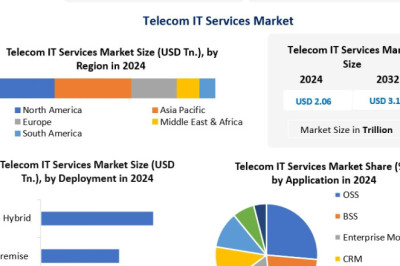views
Cybersecurity has never been more important. With the rapid rise in technology and digital adoption, cyberattacks have become a looming threat to businesses, individuals, and governments alike. But what will 2025 look like in terms of cyber threats? More importantly, how can organizations and individuals mitigate the risks?
This blog will shed light on the evolving nature of cyberattacks, explore the risks predicted for 2025, and provide actionable solutions to protect against threats like ransomware breaches and other malicious activities.
The Landscape of Cyberattacks in 2025
Cyberattacks are not a new phenomenon. However, the speed at which they are growing—in both sophistication and frequency—is alarming. By 2025, experts predict several key trends in the cybersecurity landscape that organizations need to prepare for.
Increasingly Sophisticated Ransomware Breaches
Ransomware breaches have been one of the most lucrative forms of cyberattack in recent years, and their complexity continues to evolve. Hackers are no longer just encrypting files; they are stealing sensitive data and threatening to leak it unless ransoms are paid.
For example, in 2024 alone, ransomware-related damages worldwide were estimated at over $20 billion. A study by Cybersecurity Ventures suggests this number could climb further by 2025, with businesses of all sizes being vulnerable.
The Rise of AI-driven Cyberattacks
Artificial intelligence is not just a tool for businesses; cybercriminals are using AI to develop more targeted and efficient methods of attack. AI enables hackers to automate processes like phishing emails, making them harder to detect through traditional means.
Organizations must face the reality that their existing cybersecurity measures may not be equipped to combat these AI-enhanced threats.
IoT Vulnerabilities
The proliferation of Internet of Things (IoT) devices opens up new attack surfaces for cybercriminals. With billions of connected devices expected by 2025, from smart homes to industrial IoT, these devices are quickly becoming a prime target for hackers.
One breach of a single IoT device can potentially give attackers unauthorized access to an entire network, making it critical to address their vulnerabilities.
Increased Threats to Critical Infrastructure
Attacks on critical infrastructure such as energy grids, healthcare systems, and transportation networks are expected to escalate. These systems are often the backbone of society, and a breach could cause widespread panic, financial losses, and even endanger lives.
For example, the notable Colonial Pipeline ransomware attack in 2021 demonstrated just how impactful these types of breaches can be—and this was just the beginning.
Understanding the Risks of Cyberattacks
To effectively mitigate threats, it’s crucial to understand the risks cyberattacks pose. Common risks include financial losses, reputational damage, legal consequences, and disruptions to operations.
Financial Risks
The fallout from a ransomware breach or cyberattack can be devastating to an organization’s bottom line. Costs include ransom payments, IT recovery expenses, and lost revenue during downtime. Small and medium-sized businesses (SMBs) are particularly vulnerable, with nearly 60% shutting down within six months of a major breach.
Reputational Damage
Recovering a tarnished reputation can take years. A single breach can compromise customer trust, and in the digital age, news spreads faster than businesses can respond.
Legal and Regulatory Consequences
With data protection laws like GDPR and CCPA, businesses may face severe penalties if found non-compliant after a cyberattack. Fines and lawsuits not only add financial strain but also increase scrutiny from regulatory authorities.
Operational Disruptions
Ransomware breaches often lead to downtime, as organizations scramble to recover systems and data. For industries like healthcare or finance, these operational delays can have far-reaching consequences.
Solutions to Mitigate Cyberattack Risks
While cyber threats may seem daunting, businesses and individuals can take proactive steps to reduce their risk and improve their digital resiliency. From implementing robust cybersecurity measures to staying informed, here’s how to stay ahead of the curve.
Enhance Cybersecurity Infrastructure
Investing in a strong cybersecurity infrastructure is no longer optional. Organizations should utilize advanced firewalls, intrusion detection systems, and encryption protocols to protect sensitive data.
Regular updates to software and systems keep known vulnerabilities patched, reducing the risk of breaches.
Conduct Regular Employee Training
Human error remains the weakest link in cybersecurity. Social engineering attacks, like phishing, target unsuspecting employees to gain access to systems. Regular training can help employees recognize potential threats and understand best practices.
For example, providing mock phishing tests can prepare your team to detect and report suspicious emails, reducing the likelihood of breaches.
Implement Multi-Factor Authentication (MFA)
Passwords are an easy target for hackers. MFA adds an additional layer of security by requiring users to verify their identity through a secondary method (such as a code sent to their smartphone). This small step can dramatically enhance protection.
Deploy Endpoint Detection and Response (EDR)
With remote work becoming common, endpoints like laptops and mobile devices are increasingly targeted. EDR solutions monitor and respond to threats at the device level, offering broader protection for enterprises.
Secure IoT Devices
From smart thermostats to industrial sensors, IoT security often takes a backseat. Businesses should enforce strict security policies, including device authentication and firmware updates. Segmenting IoT devices from broader networks can further limit damage from breaches.
Collaborate with Cybersecurity Experts
Sometimes, in-house teams may not have the expertise required to tackle advanced cyber threats. Collaborating with cybersecurity consultants or managed security service providers (MSSPs) can help fill these gaps.
Create an Incident Response Plan
No matter how robust your defenses are, breaches can still occur. Having a well-thought-out incident response plan ensures that your organization can quickly assess and mitigate damages while communicating transparently with stakeholders.
Organizations like NIST (National Institute of Standards and Technology) and ISO (International Organization for Standardization) provide guidelines to help businesses develop an effective incident response strategy.
Cybersecurity Is a Continuous Journey
The world of cyberattacks is constantly evolving, and staying one step ahead requires vigilance, education, and the right tools. By understanding the risks associated with cyberattacks like ransomware breach and implementing robust solutions, businesses can safeguard their operations and future-proof their growth.
Remember, cybersecurity is not a destination, but a continuous process of improvement. Start small, review your current practices, and make a commitment to ongoing learning and adaptation.











